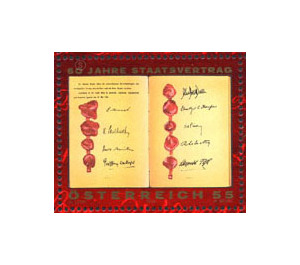60 years - Austria / II. Republic of Austria 2005 - 55 Euro Cent
Theme: Communication & Media
| Country | Austria / II. Republic of Austria |
| Issue Date | 2005 |
| Face Value | 55.00 |
| Printing Type | combination printing |
| Stamp Type | Commemorative |
| Item Type | Stamp |
| Chronological Issue Number | 1873 |
| Chronological Chapter | OOS-OE2 |
| SID | 444188 |
| In 18 Wishlists | |
The struggle for the freedom of Austria was long and laborious, but the will to freedom and independence was strong. Many energetic personalities such as Renner, Figl, Raab - to name but a few - worked long and hard on the realization. It took more than 10 years before the treaty could finally be signed after the formation of the Second Republic. Already before the end of the war political parties had formed again, which began to plan the future of Austria. The 27.04.1945 is regarded as the birth of the second republic, because the freshly formed provisional government of Austria under Dr. med. Karl Renner proclaimed the reestablishment of the Republic of Austria. On the following day, the parliament was handed over to the new federal government, which by law on 1 May 1945 restored the Austrian constitution of 1929. State Secretary Ing. Julius Raab announced the construction of the Vienna Opera as a symbol of the general reconstruction of Austria. The Western Allies invaded Austria and Austria was divided into four occupation zones. On September 1, 1945, the occupation of Vienna by the Soviet Union ended, the capital was divided like Berlin and placed under a joint administration. The new government was officially recognized on 20.10.1945 by the four occupying powers and on 25.11.1945 there were the first free national council, state and municipal elections. The second republic finally got its own new currency: the Austrian Schilling. On 18.12.1945, the government formed after the National Council elections was recognized by Chancellor Leopold Figl of the Allied Council, and one day later the constitutional reconciliation law was passed. The next day, the new National Assembly elected Dr. Karl Renner unanimously to the first Federal President of the second republic. The fight for the freedom of Austria continued and in 1955 the time had come. Julius Raab, Federal Chancellor since 1953, flew to Moscow with his government delegation in April 1955 for talks. These negotiations and the conclusion in the form of the Moscow Memorandum proved to be the final breakthrough on the road to freedom. From 2 to 13 May 1955, the ambassadors of the four occupying powers in Vienna went to a final round of preparation. On May 15, 1955, in the famous Marble Hall, the State Treaty, which established independent and democratic Austria and returned its full sovereignty to the state, was finally sealed in the Belvedere Palace. Nine signatures are on the document: The Foreign Minister and the High Commissioner of each of the four occupying powers signed: Vyacheslav M. Molotov and Ivan I. Ilyichov for the USSR, Harold Macmillan and Geoffrey A. Wallinger for Great Britain, John Foster Dulles and Llewellyn E. Thompson for the United States of America, Antoine Pinay and Roger Lalouette for France. Leopold Figl signed for Austria. "Austria is free!" is the saying that went down in history. The Austrians cheered when their foreign minister showed the state treaty on the balcony of the castle. On 27.7.1955 the State Treaty finally came into force.


